Making City Centre Car Free: Economic, Environmental and Social Perspective
VerifiedAdded on 2023/06/15
|11
|3237
|499
AI Summary
The report evaluates the impact of making city centre car free with economic, environmental and social perspective. It highlights the reasons which affect the employment and to the taxpayers with businesses. It also explains that how the unemployment can be dangerous for economy as unemployment has a direct effect on criminal activities which leads to experience more work related stress and tension. Suitable recommendations are also provided that supports better functioning of legislation of the state and making sustainable future.
Contribute Materials
Your contribution can guide someone’s learning journey. Share your
documents today.
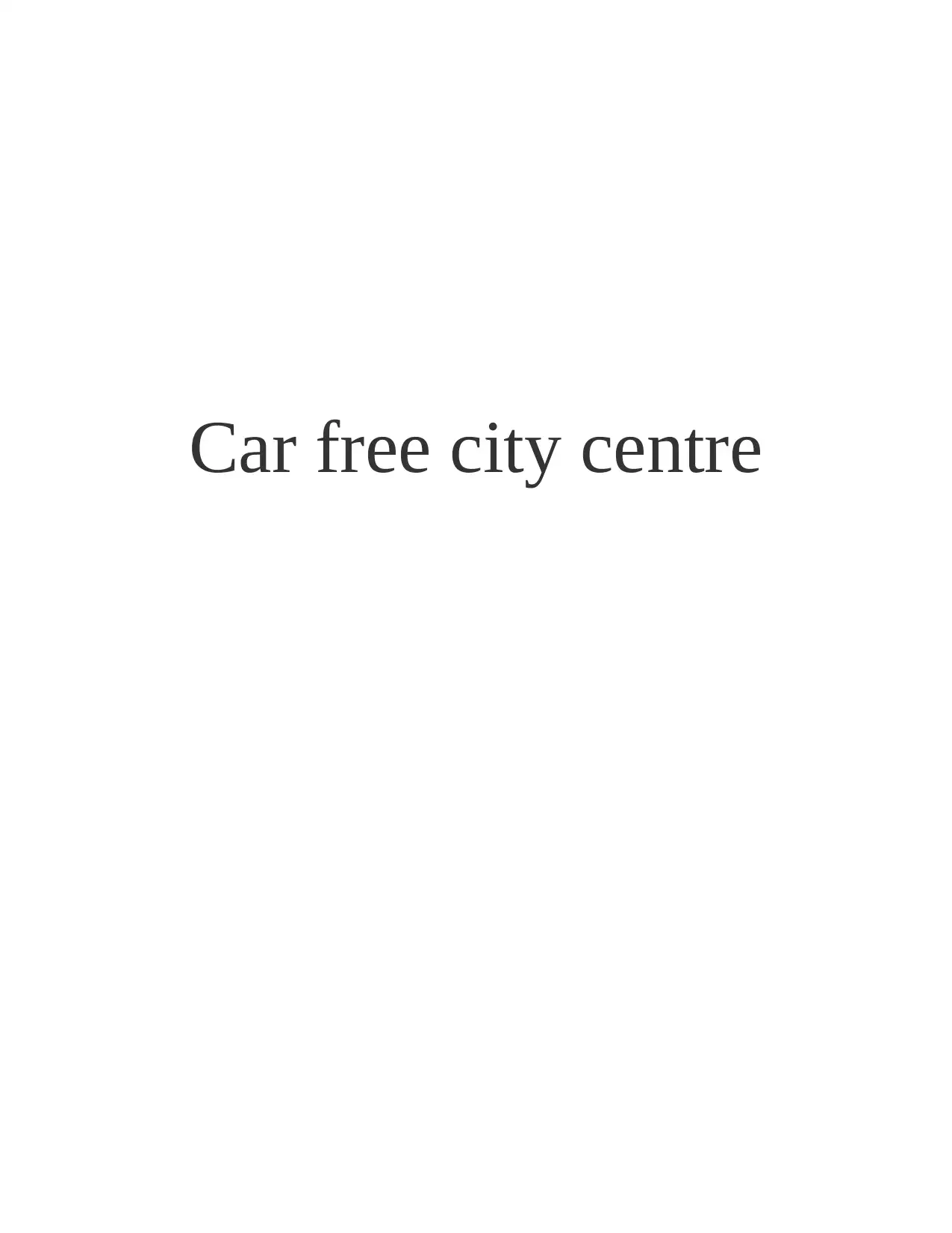
Car free city centre
Secure Best Marks with AI Grader
Need help grading? Try our AI Grader for instant feedback on your assignments.
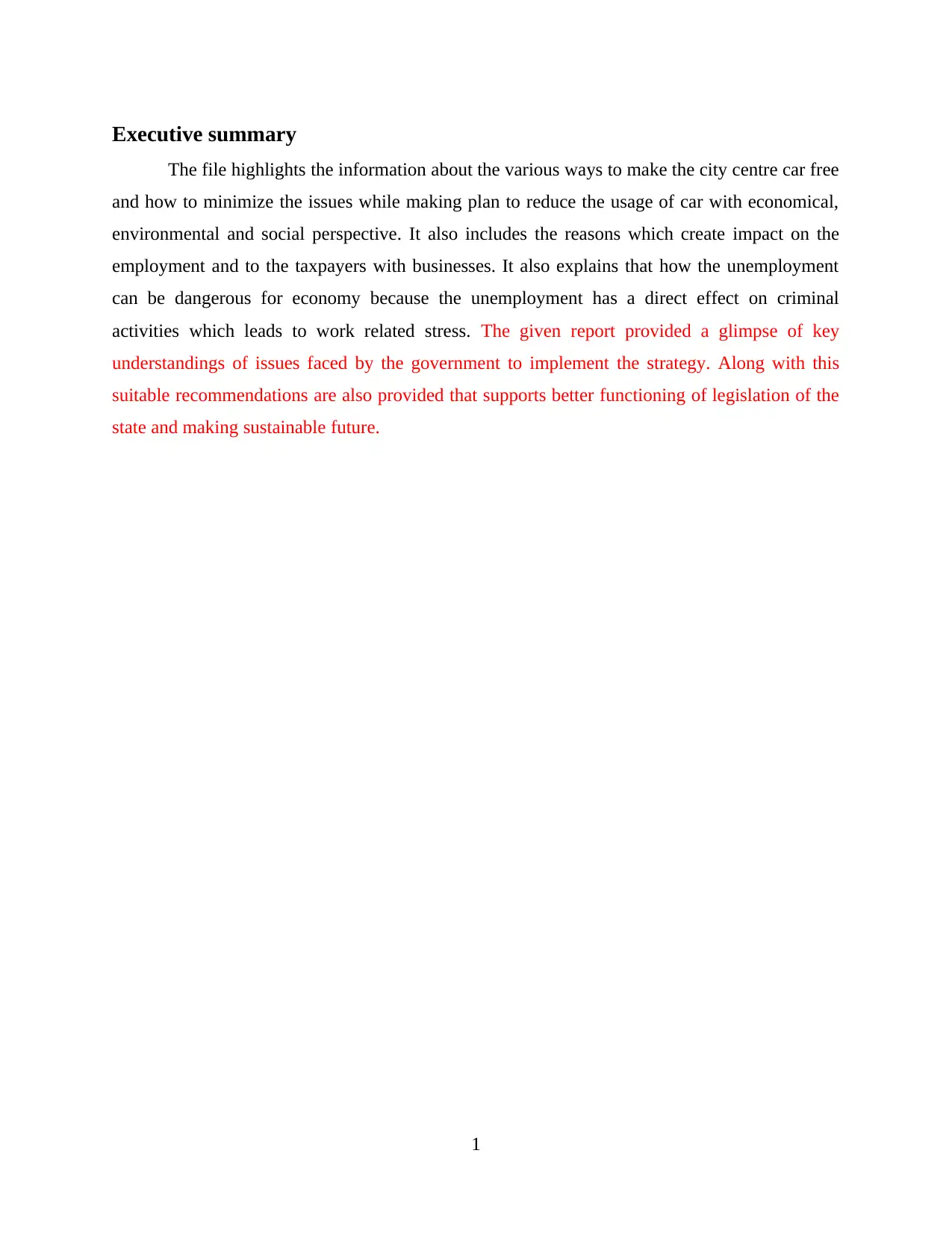
Executive summary
The file highlights the information about the various ways to make the city centre car free
and how to minimize the issues while making plan to reduce the usage of car with economical,
environmental and social perspective. It also includes the reasons which create impact on the
employment and to the taxpayers with businesses. It also explains that how the unemployment
can be dangerous for economy because the unemployment has a direct effect on criminal
activities which leads to work related stress. The given report provided a glimpse of key
understandings of issues faced by the government to implement the strategy. Along with this
suitable recommendations are also provided that supports better functioning of legislation of the
state and making sustainable future.
1
The file highlights the information about the various ways to make the city centre car free
and how to minimize the issues while making plan to reduce the usage of car with economical,
environmental and social perspective. It also includes the reasons which create impact on the
employment and to the taxpayers with businesses. It also explains that how the unemployment
can be dangerous for economy because the unemployment has a direct effect on criminal
activities which leads to work related stress. The given report provided a glimpse of key
understandings of issues faced by the government to implement the strategy. Along with this
suitable recommendations are also provided that supports better functioning of legislation of the
state and making sustainable future.
1

Table of Contents
Executive summary..........................................................................................................................1
INTRODUCTION...........................................................................................................................3
Definition of a car-free city....................................................................................................3
Discussion of stakeholder involvement..................................................................................3
Main aims of the report..........................................................................................................3
Analysis............................................................................................................................................4
Economical perspective..........................................................................................................4
Environmental perspective.....................................................................................................5
Social perspective-..................................................................................................................6
CONCLUSION................................................................................................................................7
Recommendation.............................................................................................................................8
REFERENCES..............................................................................................................................10
2
Executive summary..........................................................................................................................1
INTRODUCTION...........................................................................................................................3
Definition of a car-free city....................................................................................................3
Discussion of stakeholder involvement..................................................................................3
Main aims of the report..........................................................................................................3
Analysis............................................................................................................................................4
Economical perspective..........................................................................................................4
Environmental perspective.....................................................................................................5
Social perspective-..................................................................................................................6
CONCLUSION................................................................................................................................7
Recommendation.............................................................................................................................8
REFERENCES..............................................................................................................................10
2
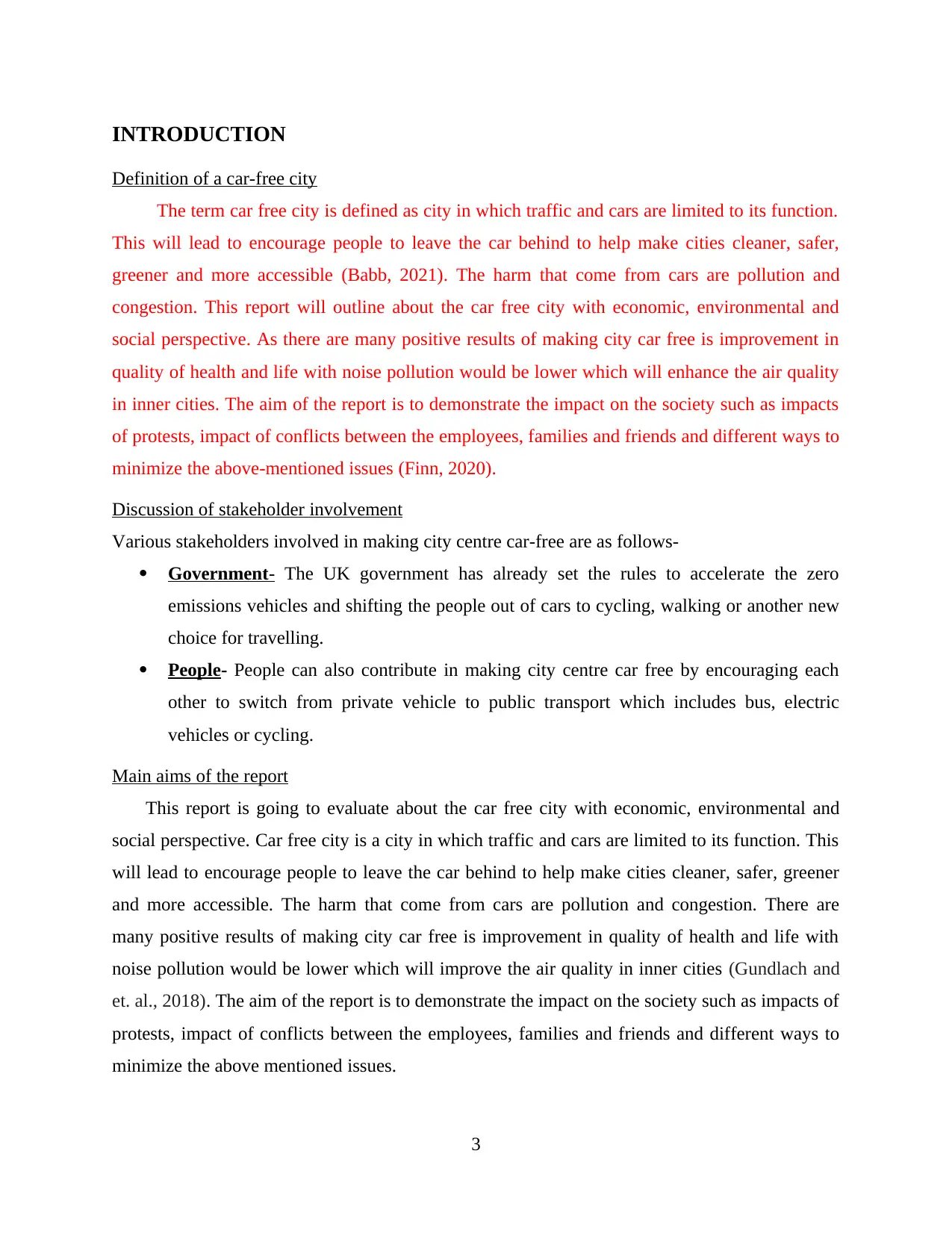
INTRODUCTION
Definition of a car-free city
The term car free city is defined as city in which traffic and cars are limited to its function.
This will lead to encourage people to leave the car behind to help make cities cleaner, safer,
greener and more accessible (Babb, 2021). The harm that come from cars are pollution and
congestion. This report will outline about the car free city with economic, environmental and
social perspective. As there are many positive results of making city car free is improvement in
quality of health and life with noise pollution would be lower which will enhance the air quality
in inner cities. The aim of the report is to demonstrate the impact on the society such as impacts
of protests, impact of conflicts between the employees, families and friends and different ways to
minimize the above-mentioned issues (Finn, 2020).
Discussion of stakeholder involvement
Various stakeholders involved in making city centre car-free are as follows-
Government- The UK government has already set the rules to accelerate the zero
emissions vehicles and shifting the people out of cars to cycling, walking or another new
choice for travelling.
People- People can also contribute in making city centre car free by encouraging each
other to switch from private vehicle to public transport which includes bus, electric
vehicles or cycling.
Main aims of the report
This report is going to evaluate about the car free city with economic, environmental and
social perspective. Car free city is a city in which traffic and cars are limited to its function. This
will lead to encourage people to leave the car behind to help make cities cleaner, safer, greener
and more accessible. The harm that come from cars are pollution and congestion. There are
many positive results of making city car free is improvement in quality of health and life with
noise pollution would be lower which will improve the air quality in inner cities (Gundlach and
et. al., 2018). The aim of the report is to demonstrate the impact on the society such as impacts of
protests, impact of conflicts between the employees, families and friends and different ways to
minimize the above mentioned issues.
3
Definition of a car-free city
The term car free city is defined as city in which traffic and cars are limited to its function.
This will lead to encourage people to leave the car behind to help make cities cleaner, safer,
greener and more accessible (Babb, 2021). The harm that come from cars are pollution and
congestion. This report will outline about the car free city with economic, environmental and
social perspective. As there are many positive results of making city car free is improvement in
quality of health and life with noise pollution would be lower which will enhance the air quality
in inner cities. The aim of the report is to demonstrate the impact on the society such as impacts
of protests, impact of conflicts between the employees, families and friends and different ways to
minimize the above-mentioned issues (Finn, 2020).
Discussion of stakeholder involvement
Various stakeholders involved in making city centre car-free are as follows-
Government- The UK government has already set the rules to accelerate the zero
emissions vehicles and shifting the people out of cars to cycling, walking or another new
choice for travelling.
People- People can also contribute in making city centre car free by encouraging each
other to switch from private vehicle to public transport which includes bus, electric
vehicles or cycling.
Main aims of the report
This report is going to evaluate about the car free city with economic, environmental and
social perspective. Car free city is a city in which traffic and cars are limited to its function. This
will lead to encourage people to leave the car behind to help make cities cleaner, safer, greener
and more accessible. The harm that come from cars are pollution and congestion. There are
many positive results of making city car free is improvement in quality of health and life with
noise pollution would be lower which will improve the air quality in inner cities (Gundlach and
et. al., 2018). The aim of the report is to demonstrate the impact on the society such as impacts of
protests, impact of conflicts between the employees, families and friends and different ways to
minimize the above mentioned issues.
3
Secure Best Marks with AI Grader
Need help grading? Try our AI Grader for instant feedback on your assignments.

Analysis
Economical perspective
Just as people have become attached to screens, they have become attached to cars. It
can be slightly difficult for the people to stop using cars so, it’s better to limit the usage of cars. It
can be done by encouraging the use of public transportation systems and also introduce solar
power to these systems. On most days, City streets are clogged with motorised traffic, crime and
pollution. Air pollution is destroying the earth as cars are powered by gasoline that contributes to
pollution. Whereas some people use overuse cars instead they can use different forms of
transportation such as buses or bicycles. Cars has become the highly important factor in this
century as it allows an easier access to the remote places (Gysels, 2020).
Banning cars would make it more difficult for people to get to work. There are different
ways to protect the environment. Car companies can manufacture electric cars which can be eco-
friendlier. In this way, environment can be protected without losing the independence. This will
benefit in increase in green space and an improved economy.
Impacts related to employment
The development in the auto mobile industry has contributed a lot in the employment distribution
If there will be no cars on the roads there are so many segments which will get affected.
Such as many taxi drivers would lose their jobs. Innovation and technology will drive the future
of the economy. There are several negative impacts too which are as follows-
Lost Jobs- Increase in electric vehicle would eliminate the jobs of people who are
working in the auto-mobile sector. New wave of technological trend would result in long-
term unemployment
Lost tax revenue- When the electrification is adopted the tax revenue will be disappeared.
Increased more Congestion- Cutting the use of cars which could result in increased
congestion because of public transport (Farda, and Balijepalli, 2018).
Costs to the taxpayer
It is natural to expect less amount of tax receipts. When a person owns a car that may
have a tax-deductible benefit. Auto-mobile industry contributes a major portion in nation
building, generating revenue, creating economic development and encouraging people to develop
overall. The government contributes huge tax revenue from its sales, business taxes, personal
4
Economical perspective
Just as people have become attached to screens, they have become attached to cars. It
can be slightly difficult for the people to stop using cars so, it’s better to limit the usage of cars. It
can be done by encouraging the use of public transportation systems and also introduce solar
power to these systems. On most days, City streets are clogged with motorised traffic, crime and
pollution. Air pollution is destroying the earth as cars are powered by gasoline that contributes to
pollution. Whereas some people use overuse cars instead they can use different forms of
transportation such as buses or bicycles. Cars has become the highly important factor in this
century as it allows an easier access to the remote places (Gysels, 2020).
Banning cars would make it more difficult for people to get to work. There are different
ways to protect the environment. Car companies can manufacture electric cars which can be eco-
friendlier. In this way, environment can be protected without losing the independence. This will
benefit in increase in green space and an improved economy.
Impacts related to employment
The development in the auto mobile industry has contributed a lot in the employment distribution
If there will be no cars on the roads there are so many segments which will get affected.
Such as many taxi drivers would lose their jobs. Innovation and technology will drive the future
of the economy. There are several negative impacts too which are as follows-
Lost Jobs- Increase in electric vehicle would eliminate the jobs of people who are
working in the auto-mobile sector. New wave of technological trend would result in long-
term unemployment
Lost tax revenue- When the electrification is adopted the tax revenue will be disappeared.
Increased more Congestion- Cutting the use of cars which could result in increased
congestion because of public transport (Farda, and Balijepalli, 2018).
Costs to the taxpayer
It is natural to expect less amount of tax receipts. When a person owns a car that may
have a tax-deductible benefit. Auto-mobile industry contributes a major portion in nation
building, generating revenue, creating economic development and encouraging people to develop
overall. The government contributes huge tax revenue from its sales, business taxes, personal
4
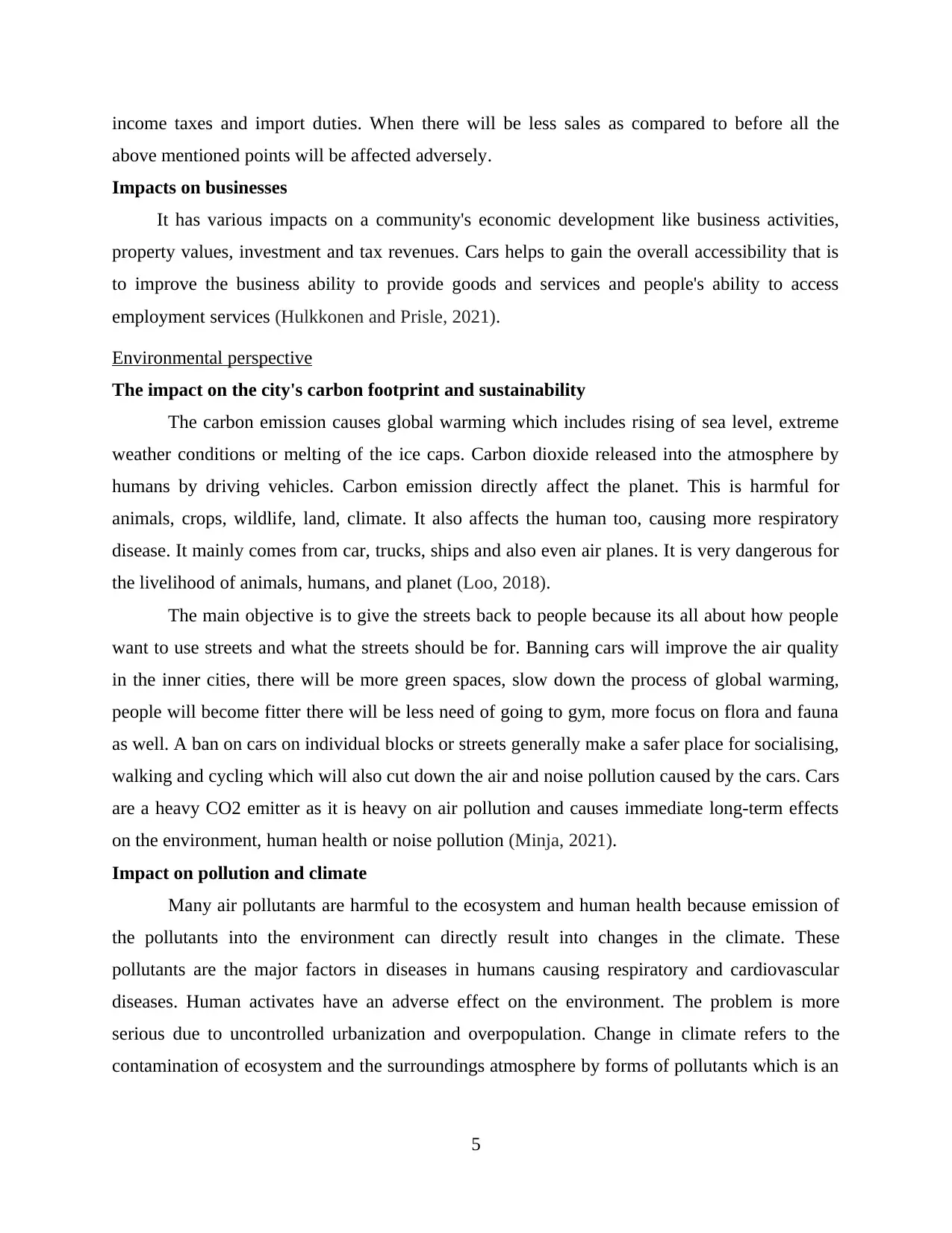
income taxes and import duties. When there will be less sales as compared to before all the
above mentioned points will be affected adversely.
Impacts on businesses
It has various impacts on a community's economic development like business activities,
property values, investment and tax revenues. Cars helps to gain the overall accessibility that is
to improve the business ability to provide goods and services and people's ability to access
employment services (Hulkkonen and Prisle, 2021).
Environmental perspective
The impact on the city's carbon footprint and sustainability
The carbon emission causes global warming which includes rising of sea level, extreme
weather conditions or melting of the ice caps. Carbon dioxide released into the atmosphere by
humans by driving vehicles. Carbon emission directly affect the planet. This is harmful for
animals, crops, wildlife, land, climate. It also affects the human too, causing more respiratory
disease. It mainly comes from car, trucks, ships and also even air planes. It is very dangerous for
the livelihood of animals, humans, and planet (Loo, 2018).
The main objective is to give the streets back to people because its all about how people
want to use streets and what the streets should be for. Banning cars will improve the air quality
in the inner cities, there will be more green spaces, slow down the process of global warming,
people will become fitter there will be less need of going to gym, more focus on flora and fauna
as well. A ban on cars on individual blocks or streets generally make a safer place for socialising,
walking and cycling which will also cut down the air and noise pollution caused by the cars. Cars
are a heavy CO2 emitter as it is heavy on air pollution and causes immediate long-term effects
on the environment, human health or noise pollution (Minja, 2021).
Impact on pollution and climate
Many air pollutants are harmful to the ecosystem and human health because emission of
the pollutants into the environment can directly result into changes in the climate. These
pollutants are the major factors in diseases in humans causing respiratory and cardiovascular
diseases. Human activates have an adverse effect on the environment. The problem is more
serious due to uncontrolled urbanization and overpopulation. Change in climate refers to the
contamination of ecosystem and the surroundings atmosphere by forms of pollutants which is an
5
above mentioned points will be affected adversely.
Impacts on businesses
It has various impacts on a community's economic development like business activities,
property values, investment and tax revenues. Cars helps to gain the overall accessibility that is
to improve the business ability to provide goods and services and people's ability to access
employment services (Hulkkonen and Prisle, 2021).
Environmental perspective
The impact on the city's carbon footprint and sustainability
The carbon emission causes global warming which includes rising of sea level, extreme
weather conditions or melting of the ice caps. Carbon dioxide released into the atmosphere by
humans by driving vehicles. Carbon emission directly affect the planet. This is harmful for
animals, crops, wildlife, land, climate. It also affects the human too, causing more respiratory
disease. It mainly comes from car, trucks, ships and also even air planes. It is very dangerous for
the livelihood of animals, humans, and planet (Loo, 2018).
The main objective is to give the streets back to people because its all about how people
want to use streets and what the streets should be for. Banning cars will improve the air quality
in the inner cities, there will be more green spaces, slow down the process of global warming,
people will become fitter there will be less need of going to gym, more focus on flora and fauna
as well. A ban on cars on individual blocks or streets generally make a safer place for socialising,
walking and cycling which will also cut down the air and noise pollution caused by the cars. Cars
are a heavy CO2 emitter as it is heavy on air pollution and causes immediate long-term effects
on the environment, human health or noise pollution (Minja, 2021).
Impact on pollution and climate
Many air pollutants are harmful to the ecosystem and human health because emission of
the pollutants into the environment can directly result into changes in the climate. These
pollutants are the major factors in diseases in humans causing respiratory and cardiovascular
diseases. Human activates have an adverse effect on the environment. The problem is more
serious due to uncontrolled urbanization and overpopulation. Change in climate refers to the
contamination of ecosystem and the surroundings atmosphere by forms of pollutants which is an
5
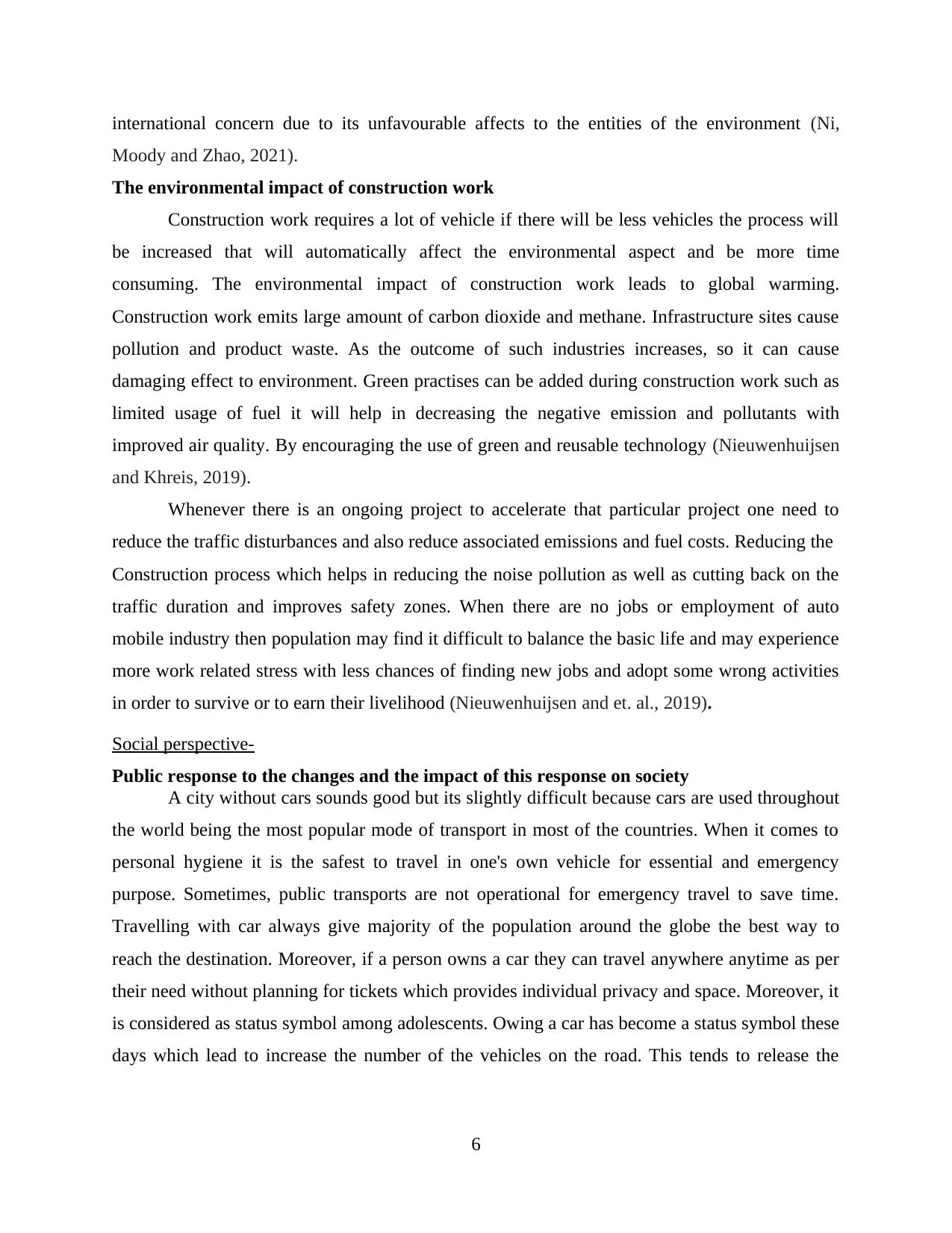
international concern due to its unfavourable affects to the entities of the environment (Ni,
Moody and Zhao, 2021).
The environmental impact of construction work
Construction work requires a lot of vehicle if there will be less vehicles the process will
be increased that will automatically affect the environmental aspect and be more time
consuming. The environmental impact of construction work leads to global warming.
Construction work emits large amount of carbon dioxide and methane. Infrastructure sites cause
pollution and product waste. As the outcome of such industries increases, so it can cause
damaging effect to environment. Green practises can be added during construction work such as
limited usage of fuel it will help in decreasing the negative emission and pollutants with
improved air quality. By encouraging the use of green and reusable technology (Nieuwenhuijsen
and Khreis, 2019).
Whenever there is an ongoing project to accelerate that particular project one need to
reduce the traffic disturbances and also reduce associated emissions and fuel costs. Reducing the
Construction process which helps in reducing the noise pollution as well as cutting back on the
traffic duration and improves safety zones. When there are no jobs or employment of auto
mobile industry then population may find it difficult to balance the basic life and may experience
more work related stress with less chances of finding new jobs and adopt some wrong activities
in order to survive or to earn their livelihood (Nieuwenhuijsen and et. al., 2019).
Social perspective-
Public response to the changes and the impact of this response on society
A city without cars sounds good but its slightly difficult because cars are used throughout
the world being the most popular mode of transport in most of the countries. When it comes to
personal hygiene it is the safest to travel in one's own vehicle for essential and emergency
purpose. Sometimes, public transports are not operational for emergency travel to save time.
Travelling with car always give majority of the population around the globe the best way to
reach the destination. Moreover, if a person owns a car they can travel anywhere anytime as per
their need without planning for tickets which provides individual privacy and space. Moreover, it
is considered as status symbol among adolescents. Owing a car has become a status symbol these
days which lead to increase the number of the vehicles on the road. This tends to release the
6
Moody and Zhao, 2021).
The environmental impact of construction work
Construction work requires a lot of vehicle if there will be less vehicles the process will
be increased that will automatically affect the environmental aspect and be more time
consuming. The environmental impact of construction work leads to global warming.
Construction work emits large amount of carbon dioxide and methane. Infrastructure sites cause
pollution and product waste. As the outcome of such industries increases, so it can cause
damaging effect to environment. Green practises can be added during construction work such as
limited usage of fuel it will help in decreasing the negative emission and pollutants with
improved air quality. By encouraging the use of green and reusable technology (Nieuwenhuijsen
and Khreis, 2019).
Whenever there is an ongoing project to accelerate that particular project one need to
reduce the traffic disturbances and also reduce associated emissions and fuel costs. Reducing the
Construction process which helps in reducing the noise pollution as well as cutting back on the
traffic duration and improves safety zones. When there are no jobs or employment of auto
mobile industry then population may find it difficult to balance the basic life and may experience
more work related stress with less chances of finding new jobs and adopt some wrong activities
in order to survive or to earn their livelihood (Nieuwenhuijsen and et. al., 2019).
Social perspective-
Public response to the changes and the impact of this response on society
A city without cars sounds good but its slightly difficult because cars are used throughout
the world being the most popular mode of transport in most of the countries. When it comes to
personal hygiene it is the safest to travel in one's own vehicle for essential and emergency
purpose. Sometimes, public transports are not operational for emergency travel to save time.
Travelling with car always give majority of the population around the globe the best way to
reach the destination. Moreover, if a person owns a car they can travel anywhere anytime as per
their need without planning for tickets which provides individual privacy and space. Moreover, it
is considered as status symbol among adolescents. Owing a car has become a status symbol these
days which lead to increase the number of the vehicles on the road. This tends to release the
6
Paraphrase This Document
Need a fresh take? Get an instant paraphrase of this document with our AI Paraphraser
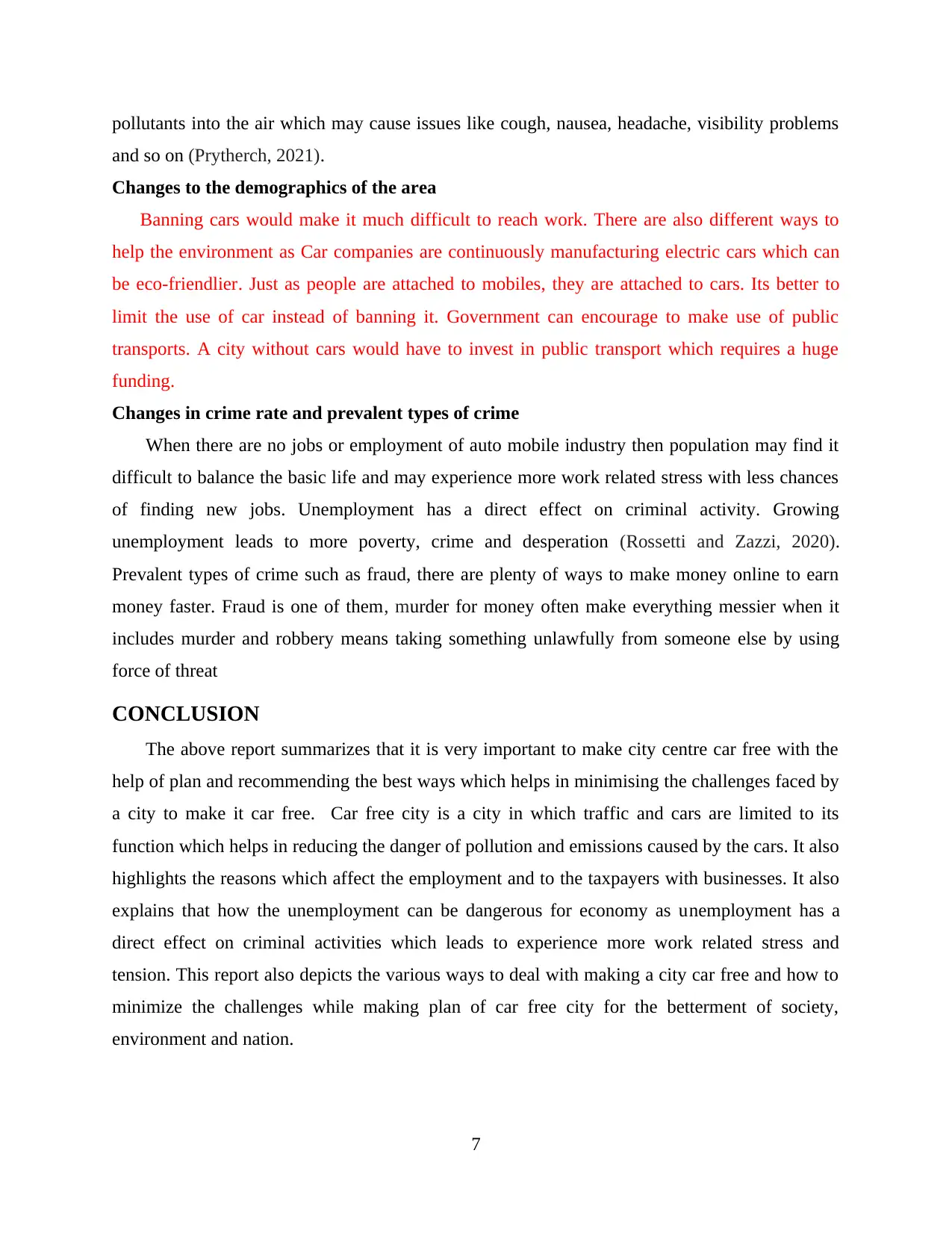
pollutants into the air which may cause issues like cough, nausea, headache, visibility problems
and so on (Prytherch, 2021).
Changes to the demographics of the area
Banning cars would make it much difficult to reach work. There are also different ways to
help the environment as Car companies are continuously manufacturing electric cars which can
be eco-friendlier. Just as people are attached to mobiles, they are attached to cars. Its better to
limit the use of car instead of banning it. Government can encourage to make use of public
transports. A city without cars would have to invest in public transport which requires a huge
funding.
Changes in crime rate and prevalent types of crime
When there are no jobs or employment of auto mobile industry then population may find it
difficult to balance the basic life and may experience more work related stress with less chances
of finding new jobs. Unemployment has a direct effect on criminal activity. Growing
unemployment leads to more poverty, crime and desperation (Rossetti and Zazzi, 2020).
Prevalent types of crime such as fraud, there are plenty of ways to make money online to earn
money faster. Fraud is one of them, murder for money often make everything messier when it
includes murder and robbery means taking something unlawfully from someone else by using
force of threat
CONCLUSION
The above report summarizes that it is very important to make city centre car free with the
help of plan and recommending the best ways which helps in minimising the challenges faced by
a city to make it car free. Car free city is a city in which traffic and cars are limited to its
function which helps in reducing the danger of pollution and emissions caused by the cars. It also
highlights the reasons which affect the employment and to the taxpayers with businesses. It also
explains that how the unemployment can be dangerous for economy as unemployment has a
direct effect on criminal activities which leads to experience more work related stress and
tension. This report also depicts the various ways to deal with making a city car free and how to
minimize the challenges while making plan of car free city for the betterment of society,
environment and nation.
7
and so on (Prytherch, 2021).
Changes to the demographics of the area
Banning cars would make it much difficult to reach work. There are also different ways to
help the environment as Car companies are continuously manufacturing electric cars which can
be eco-friendlier. Just as people are attached to mobiles, they are attached to cars. Its better to
limit the use of car instead of banning it. Government can encourage to make use of public
transports. A city without cars would have to invest in public transport which requires a huge
funding.
Changes in crime rate and prevalent types of crime
When there are no jobs or employment of auto mobile industry then population may find it
difficult to balance the basic life and may experience more work related stress with less chances
of finding new jobs. Unemployment has a direct effect on criminal activity. Growing
unemployment leads to more poverty, crime and desperation (Rossetti and Zazzi, 2020).
Prevalent types of crime such as fraud, there are plenty of ways to make money online to earn
money faster. Fraud is one of them, murder for money often make everything messier when it
includes murder and robbery means taking something unlawfully from someone else by using
force of threat
CONCLUSION
The above report summarizes that it is very important to make city centre car free with the
help of plan and recommending the best ways which helps in minimising the challenges faced by
a city to make it car free. Car free city is a city in which traffic and cars are limited to its
function which helps in reducing the danger of pollution and emissions caused by the cars. It also
highlights the reasons which affect the employment and to the taxpayers with businesses. It also
explains that how the unemployment can be dangerous for economy as unemployment has a
direct effect on criminal activities which leads to experience more work related stress and
tension. This report also depicts the various ways to deal with making a city car free and how to
minimize the challenges while making plan of car free city for the betterment of society,
environment and nation.
7
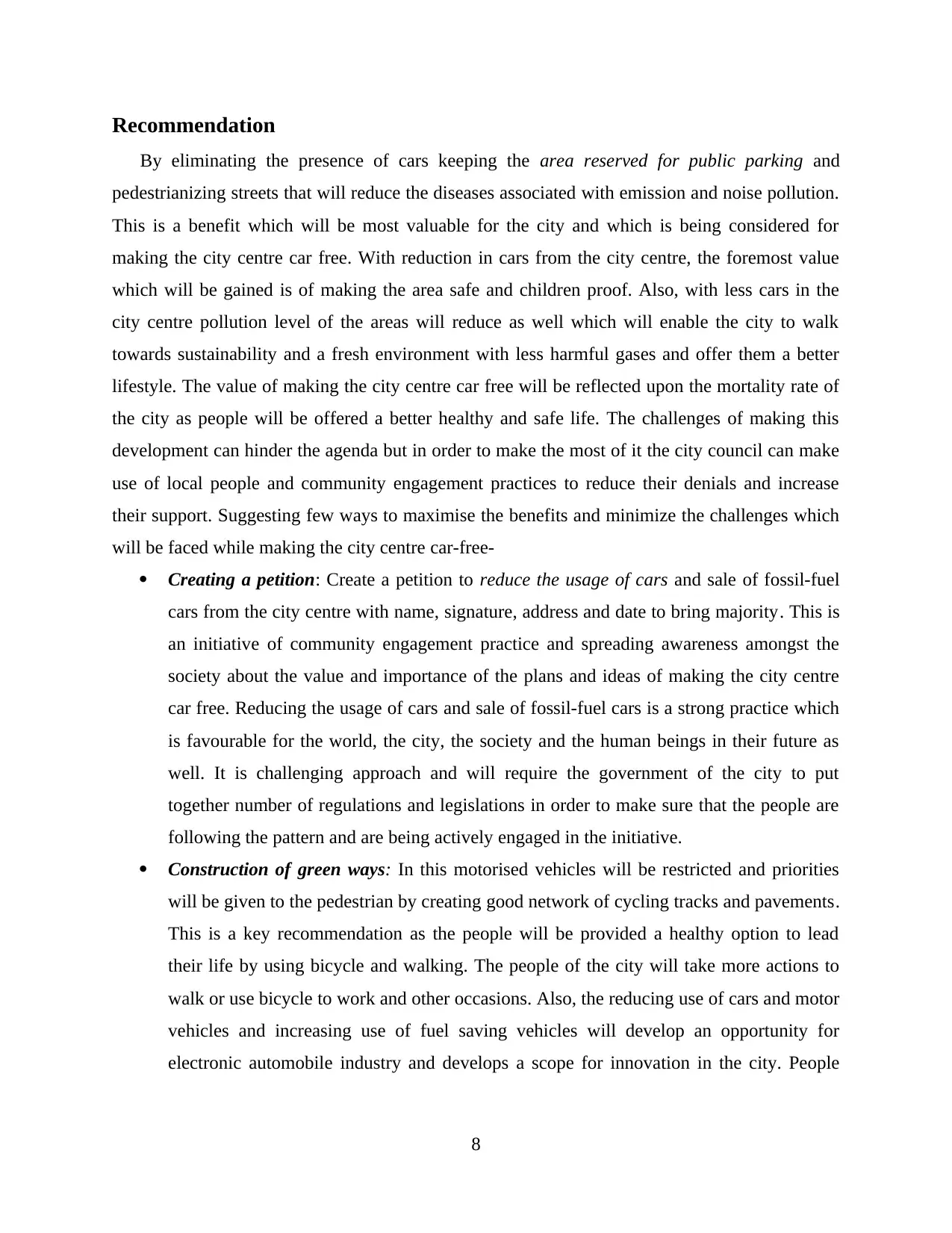
Recommendation
By eliminating the presence of cars keeping the area reserved for public parking and
pedestrianizing streets that will reduce the diseases associated with emission and noise pollution.
This is a benefit which will be most valuable for the city and which is being considered for
making the city centre car free. With reduction in cars from the city centre, the foremost value
which will be gained is of making the area safe and children proof. Also, with less cars in the
city centre pollution level of the areas will reduce as well which will enable the city to walk
towards sustainability and a fresh environment with less harmful gases and offer them a better
lifestyle. The value of making the city centre car free will be reflected upon the mortality rate of
the city as people will be offered a better healthy and safe life. The challenges of making this
development can hinder the agenda but in order to make the most of it the city council can make
use of local people and community engagement practices to reduce their denials and increase
their support. Suggesting few ways to maximise the benefits and minimize the challenges which
will be faced while making the city centre car-free-
Creating a petition: Create a petition to reduce the usage of cars and sale of fossil-fuel
cars from the city centre with name, signature, address and date to bring majority. This is
an initiative of community engagement practice and spreading awareness amongst the
society about the value and importance of the plans and ideas of making the city centre
car free. Reducing the usage of cars and sale of fossil-fuel cars is a strong practice which
is favourable for the world, the city, the society and the human beings in their future as
well. It is challenging approach and will require the government of the city to put
together number of regulations and legislations in order to make sure that the people are
following the pattern and are being actively engaged in the initiative.
Construction of green ways: In this motorised vehicles will be restricted and priorities
will be given to the pedestrian by creating good network of cycling tracks and pavements.
This is a key recommendation as the people will be provided a healthy option to lead
their life by using bicycle and walking. The people of the city will take more actions to
walk or use bicycle to work and other occasions. Also, the reducing use of cars and motor
vehicles and increasing use of fuel saving vehicles will develop an opportunity for
electronic automobile industry and develops a scope for innovation in the city. People
8
By eliminating the presence of cars keeping the area reserved for public parking and
pedestrianizing streets that will reduce the diseases associated with emission and noise pollution.
This is a benefit which will be most valuable for the city and which is being considered for
making the city centre car free. With reduction in cars from the city centre, the foremost value
which will be gained is of making the area safe and children proof. Also, with less cars in the
city centre pollution level of the areas will reduce as well which will enable the city to walk
towards sustainability and a fresh environment with less harmful gases and offer them a better
lifestyle. The value of making the city centre car free will be reflected upon the mortality rate of
the city as people will be offered a better healthy and safe life. The challenges of making this
development can hinder the agenda but in order to make the most of it the city council can make
use of local people and community engagement practices to reduce their denials and increase
their support. Suggesting few ways to maximise the benefits and minimize the challenges which
will be faced while making the city centre car-free-
Creating a petition: Create a petition to reduce the usage of cars and sale of fossil-fuel
cars from the city centre with name, signature, address and date to bring majority. This is
an initiative of community engagement practice and spreading awareness amongst the
society about the value and importance of the plans and ideas of making the city centre
car free. Reducing the usage of cars and sale of fossil-fuel cars is a strong practice which
is favourable for the world, the city, the society and the human beings in their future as
well. It is challenging approach and will require the government of the city to put
together number of regulations and legislations in order to make sure that the people are
following the pattern and are being actively engaged in the initiative.
Construction of green ways: In this motorised vehicles will be restricted and priorities
will be given to the pedestrian by creating good network of cycling tracks and pavements.
This is a key recommendation as the people will be provided a healthy option to lead
their life by using bicycle and walking. The people of the city will take more actions to
walk or use bicycle to work and other occasions. Also, the reducing use of cars and motor
vehicles and increasing use of fuel saving vehicles will develop an opportunity for
electronic automobile industry and develops a scope for innovation in the city. People
8

will be exploring more options which are sustainable and environmental friendly and
enable the society a chance to grow and evolve.
9
enable the society a chance to grow and evolve.
9
Secure Best Marks with AI Grader
Need help grading? Try our AI Grader for instant feedback on your assignments.
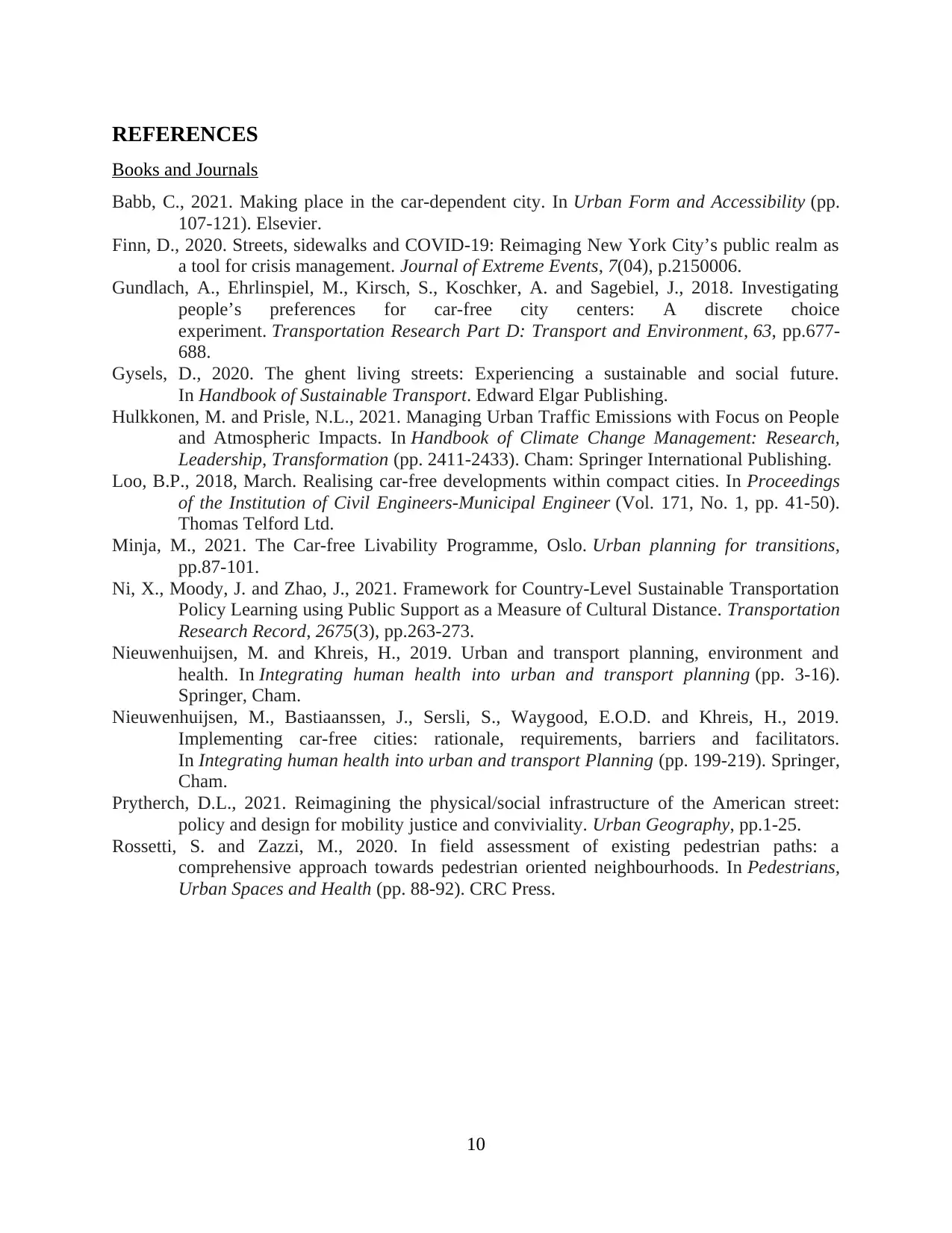
REFERENCES
Books and Journals
Babb, C., 2021. Making place in the car-dependent city. In Urban Form and Accessibility (pp.
107-121). Elsevier.
Finn, D., 2020. Streets, sidewalks and COVID-19: Reimaging New York City’s public realm as
a tool for crisis management. Journal of Extreme Events, 7(04), p.2150006.
Gundlach, A., Ehrlinspiel, M., Kirsch, S., Koschker, A. and Sagebiel, J., 2018. Investigating
people’s preferences for car-free city centers: A discrete choice
experiment. Transportation Research Part D: Transport and Environment, 63, pp.677-
688.
Gysels, D., 2020. The ghent living streets: Experiencing a sustainable and social future.
In Handbook of Sustainable Transport. Edward Elgar Publishing.
Hulkkonen, M. and Prisle, N.L., 2021. Managing Urban Traffic Emissions with Focus on People
and Atmospheric Impacts. In Handbook of Climate Change Management: Research,
Leadership, Transformation (pp. 2411-2433). Cham: Springer International Publishing.
Loo, B.P., 2018, March. Realising car-free developments within compact cities. In Proceedings
of the Institution of Civil Engineers-Municipal Engineer (Vol. 171, No. 1, pp. 41-50).
Thomas Telford Ltd.
Minja, M., 2021. The Car‐free Livability Programme, Oslo. Urban planning for transitions,
pp.87-101.
Ni, X., Moody, J. and Zhao, J., 2021. Framework for Country-Level Sustainable Transportation
Policy Learning using Public Support as a Measure of Cultural Distance. Transportation
Research Record, 2675(3), pp.263-273.
Nieuwenhuijsen, M. and Khreis, H., 2019. Urban and transport planning, environment and
health. In Integrating human health into urban and transport planning (pp. 3-16).
Springer, Cham.
Nieuwenhuijsen, M., Bastiaanssen, J., Sersli, S., Waygood, E.O.D. and Khreis, H., 2019.
Implementing car-free cities: rationale, requirements, barriers and facilitators.
In Integrating human health into urban and transport Planning (pp. 199-219). Springer,
Cham.
Prytherch, D.L., 2021. Reimagining the physical/social infrastructure of the American street:
policy and design for mobility justice and conviviality. Urban Geography, pp.1-25.
Rossetti, S. and Zazzi, M., 2020. In field assessment of existing pedestrian paths: a
comprehensive approach towards pedestrian oriented neighbourhoods. In Pedestrians,
Urban Spaces and Health (pp. 88-92). CRC Press.
10
Books and Journals
Babb, C., 2021. Making place in the car-dependent city. In Urban Form and Accessibility (pp.
107-121). Elsevier.
Finn, D., 2020. Streets, sidewalks and COVID-19: Reimaging New York City’s public realm as
a tool for crisis management. Journal of Extreme Events, 7(04), p.2150006.
Gundlach, A., Ehrlinspiel, M., Kirsch, S., Koschker, A. and Sagebiel, J., 2018. Investigating
people’s preferences for car-free city centers: A discrete choice
experiment. Transportation Research Part D: Transport and Environment, 63, pp.677-
688.
Gysels, D., 2020. The ghent living streets: Experiencing a sustainable and social future.
In Handbook of Sustainable Transport. Edward Elgar Publishing.
Hulkkonen, M. and Prisle, N.L., 2021. Managing Urban Traffic Emissions with Focus on People
and Atmospheric Impacts. In Handbook of Climate Change Management: Research,
Leadership, Transformation (pp. 2411-2433). Cham: Springer International Publishing.
Loo, B.P., 2018, March. Realising car-free developments within compact cities. In Proceedings
of the Institution of Civil Engineers-Municipal Engineer (Vol. 171, No. 1, pp. 41-50).
Thomas Telford Ltd.
Minja, M., 2021. The Car‐free Livability Programme, Oslo. Urban planning for transitions,
pp.87-101.
Ni, X., Moody, J. and Zhao, J., 2021. Framework for Country-Level Sustainable Transportation
Policy Learning using Public Support as a Measure of Cultural Distance. Transportation
Research Record, 2675(3), pp.263-273.
Nieuwenhuijsen, M. and Khreis, H., 2019. Urban and transport planning, environment and
health. In Integrating human health into urban and transport planning (pp. 3-16).
Springer, Cham.
Nieuwenhuijsen, M., Bastiaanssen, J., Sersli, S., Waygood, E.O.D. and Khreis, H., 2019.
Implementing car-free cities: rationale, requirements, barriers and facilitators.
In Integrating human health into urban and transport Planning (pp. 199-219). Springer,
Cham.
Prytherch, D.L., 2021. Reimagining the physical/social infrastructure of the American street:
policy and design for mobility justice and conviviality. Urban Geography, pp.1-25.
Rossetti, S. and Zazzi, M., 2020. In field assessment of existing pedestrian paths: a
comprehensive approach towards pedestrian oriented neighbourhoods. In Pedestrians,
Urban Spaces and Health (pp. 88-92). CRC Press.
10
1 out of 11
Related Documents
Your All-in-One AI-Powered Toolkit for Academic Success.
+13062052269
info@desklib.com
Available 24*7 on WhatsApp / Email
![[object Object]](/_next/static/media/star-bottom.7253800d.svg)
Unlock your academic potential
© 2024 | Zucol Services PVT LTD | All rights reserved.



